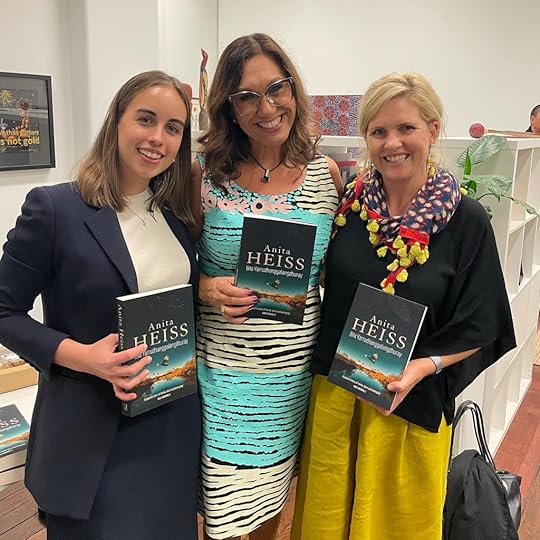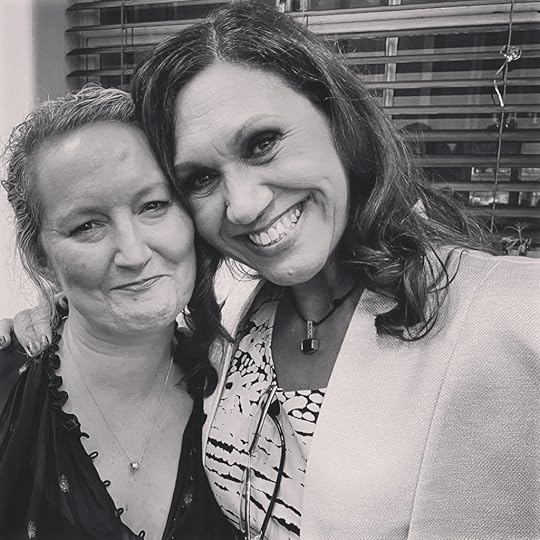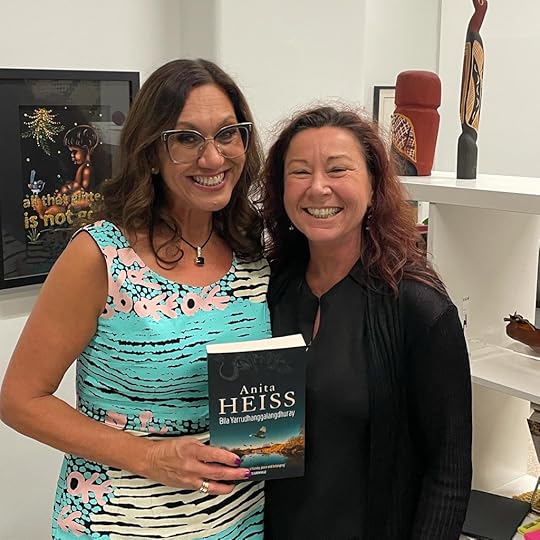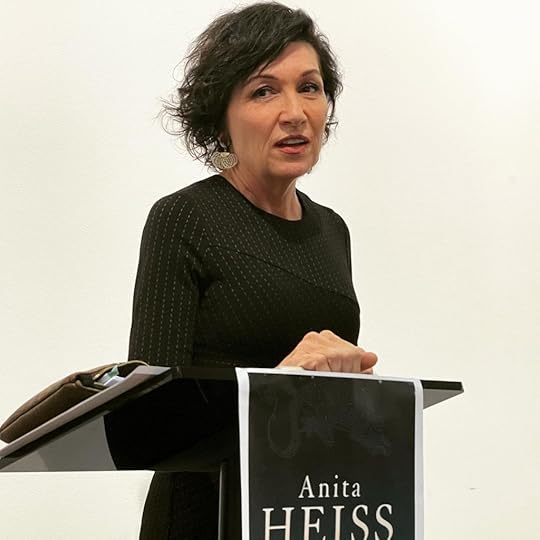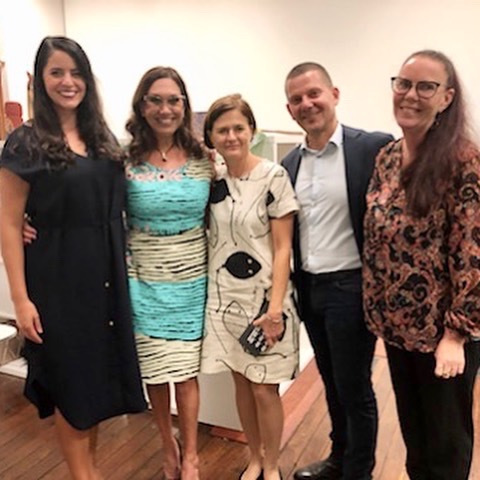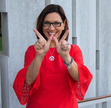Anita Heiss's Blog, page 6
June 27, 2021
Five questions with Linda Jaivin

Linda Jaivin is the author of twelve books -seven novels and four book-length works of non-fiction. Her most recent novel is The Empress Lover, and her latest book is The Shortest History of China published May 2021, which is quite possibly the only book on Chinese history that acknowledges First Nations Australians. On p.255 she writes: ‘I live and work on the land of the Gadigal people, over which sovereignty has never been ceded. I also wrote some of the book on sovereign Darug and Gundungurra land, at the Varuna Writer’s House.
Linda’s very early works of fiction are also worth mentioning and include – Eat Me, Miles Walker, You’re Dead, and The Infernal Optimist – because they show Linda’s skill in working across genres and themes.
Today we’re yarning about The Shortest History of China.

How on earth do you write the “shortest history” of a country with 3,500 years of written records?
It was a daunting task, but I decided to make it even harder for myself by starting with the mythic creation of the universe and then working my way forwards until I got to the present day – wolf warriors, Covid-19 and all. Naturally, when I was done, I had to cut out tens of thousands of words until it could credibly be called The Shortest History of China. I was still determined to get all the fun stuff in – the great novels, the brilliant weirdos, the palace intrigues, Tang dynasty makeup trends, that kind of thing. One trick I used was to find one fabulous example of a larger phenomenon or trend – so in talking about the polymorphously corrupt eunuchs of the Ming dynasty, I only go into detail about the loot acquired by one, which included two solid-gold suits of armour, 4,162 jade belts and bushels of gemstones. There are lots of controversies in Chinese history, some of which have been argued about for thousands of years, such as that around the legacy of Confucius – with these I mention the controversy and briefly sum up the main positions. It’s my hope that readers will be inspired to read and learn more about the subject – there’s plenty to learn!
You quote a lot of poetry in The Shortest History of China, which is something we don’t see a lot in history books – what does poetry tell us about China and its history?
Poetry is such an essential part of Chinese culture, and many poems offer brilliant insights into bigger events. You can read about people fleeing a violent rebellion in ancient times and understand it on an intellectual level. But when you read a poem in which the poet describes sleeping under trees, his infant daughter biting him in her hunger and the confused bravery of his little son as for “Ten days, half in rain and thunder, through mud and slime we pulled each other on”, it hits you in the heart. One of China’s most ancient books (compiled between the 11th and 7th centuries BCE) is the Book of Odes, which includes many folk songs, including some that satirise the ruling classes. So poetry is a window that gives an intimate glimpse into lived experience. Besides, so much of it is so beautiful that, well, how could you leave it out?
Tell us about the women you write about – they play a larger role in your book than in most general short histories.
They certainly do! When I started researching this book, there were women I already knew about and wanted to include, like the warrior Sun Ren, whose one hundred sword-wielding handmaidens caused the king she married to quake every time he entered her bedroom, and some of the feisty feminists of the early twentieth century. But I also wanted to include those whose tend to be overlooked: the historians, inventors, diplomats and scientists… it was hard not to include them all but, you know, shortest history and all that.
How important is at least knowing a little bit about the Chinese language to understanding China as a whole?
The Chinese language is a pillar of the civilisation. In the book, I describe how it works (very differently from alphabetic languages) and its evolution, including the process by which the national language – Putonghua – was created. I consider learning Chinese one of the best decisions I ever made in my life and hope the book inspires some readers to take the plunge as well. Hard, but worth it.
What can Chinese history tell us about China today?
So much! There are themes that run through Chinese history which resonate today: the fear that corruption will weaken the state, the obsession with unity and stability, and the question of how to achieve a peaceful and orderly succession from one ruler to another, for example. Once you become aware of it, you can also recognise how important the telling of history is to the Communist Party of China’s claim on legitimacy, and why it censors and punishes historians who question the party line. The final chapter of the book highlights some of these echoes and controversies and enduring themes.
To find out more about Linda head to her website and / or follow her on Instagram .
Bookshops where you can find Linda’s work includes Gleebooks , Potts Point Bookshop , Avid Reader , and Asia Book Room .
And drop a question in the comment box about The Shortest History of China or a line about your favourite Linda Jaivin novel.
June 20, 2021
Five Questions with bestselling author Rachael Johns
My next amazing author-guest is the prolific Rachael Johns who has published 28 books across formats with a number of publishers. She is the bestselling, ABIA-winning author of The Patterson Girls and a number of other romance and women’s fiction books, including her recent bestseller, How to Mend a Broken Heart.
Rachael is currently Australia’s leading writer of contemporary relationship stories around women’s issues, a genre she has coined ‘life-lit’.
But wait, there’s more!
Jilted (her first rural romance) won Favourite Australian Contemporary Romance in 2012, and The Patterson Girls won the 2016 Romance Writers of Australia RUBY Award and also the 2015 Australian Book Industry Award for General Fiction. She continually places in Booktopia’s Top 50 Aussie Authors poll.
Rachael is an English teacher by trade, a mum 24/7, a Diet Coke addict (trust me I have seen this in action), a cat lover and chronic arachnophobe.
You’re probably inspired just reading that very short bio of Rachael – but don’t stop now, read a little more about her latest book How to Mend a Broken Heart, get some very helpful tips on writing, and leave a comment below about your fave Rachael Johns title.

Your latest book, HOW TO MEND A BROKEN HEART , is set in New Orleans, why did you choose to write a book set here?
I went to NOLA for a writing conference in 2014 and ended up spending more time strolling the streets and exploring the magic of French Quarter than I did at the conference. I fell in love with the eclectic nature of the place – I loved that all sorts of people could be found there. I loved that I could see a woman in a twin set and pearls and next to her there’d be someone wearing skimpy clothes while they sang gospel songs (no kidding). I love the art, the music, the food, the beautiful architecture inspired by French and Spanish settlers to the area, but to be honest, the thing I love best of all is that it’s supposedly one of the most haunted cities in America. From that very first visit, I knew I wanted to come back there and explore further and most importantly, I knew I wanted to write a book set there. But it was a few more years before I found the right story!
What were your other inspirations?
I wrote a book in 2015 called The Art of Keeping Secrets about three friends who all have a secret, and readers have been asking me for a sequel to that book ever since. I never intended to write one but after a while I started to realise that maybe there was room for more story for ONE of the characters. In this book two of the women have a pretty standard happy ending, but Felicity Bell’s story ends a little bit up in the air. I thought about Flick for years and years and she refused to leave me alone, so I decided to continue her story after the book but instead include her two friends again, I chose to use her 25 year old daughter as one of the other point-of-view characters. In this way, the book is not a sequel but more of a linked book – you do NOT have to read The Art of Keeping Secrets to read (and hopefully) enjoy How to Mend a Broken Heart. I wrote it as a standalone.
The other inspiration came from the character of Miss Havisham (written by Charles Dickens in Great Expectations). When I read this book in high school this character completely captivated me. For anyone who doesn’t know, Miss Havisham was left at the altar on her wedding day and spent her life wearing her wedding dress and feeling bitter about men. She even passed this bitterness onto her young ward, Estella. I’ve always wanted to write a modern day Miss Havisham and the setting of New Orleans felt perfect for her. She lives in a derelict old mansion in the Garden District, however there is a slight twist to her story.
What is your absolute favourite thing about being an author?
You mean aside from the millions of dollars in my bank account? (that’s a joke for anyone who thinks ALL authors are billionaires). I’m going to be cheeky and choose two things. 1) Getting to work in my pjs or daggy clothes and not having to wear make-up on a daily basis. 2) Reader feedback – there’s nothing better than getting a message from a reader telling you how much they loved your book, how it touched them or helped them through a difficult time in their life. Sometimes it’s easy to feel like I’m not really doing anything important, but then I get reader mail and I realise there are many, many ways to make a difference in the world.
Recently while at the Capricorn Coast Writers Festival you spoke about book snobbery, what are two myths about popular fiction you want to bust.
Myth #1 – that easy reading is easy writing. So many people who have never attempted to write, believe that commercial/popular fiction must be easy to write because it is so damn easy to read, but the truth is that genre writers also bleed onto the page and turn them inside out trying to write the best book.
Myth #2 – that popular fiction doesn’t have any substance. I’ve heard people write off romance and women’s fiction books as being ‘light and fluffy’ when what I really think they mean is that they were comforting page-turners. (Either that or they’ve never actually read the books they describe in this way). The truth is all my books and those of other authors I read in similar genres delve into deep issues and universal themes just as much as authors of serious, literary fiction. In my books I’ve explored alcoholism, nest parenting, egg donation, wind farming, organ donation, and prolonged grief disorder to name just a few.
Do you have any advice for aspiring authors?
Do I ever?!
1) Join an organisation of writers – my choice is Romance Writers of Australia as they were the reason I went from years of aimlessly trying to get published to actually writing something that got picked up by a publisher. There’s nothing like being surrounded by other writers for inspiration, motivation and education.
2) Don’t rush – I see so many people these days who value getting published more than actually writing a good book. I took years to learn my craft and wrote many books that will never see the light of day, but that’s okay. A plumber or a brain surgeon don’t decide one day they want to be a plumber or a brain surgeon and start working the next day – they have to study and train for years. Don’t expect brilliance the moment you decide to write.
3) Try not to compare your first draft with the published novel you are reading – remember that book too was a first draft once and since then has been through numerous edits to bring it up to standard. Better still, don’t compare yourself or your writing with anyone. Run your own race.
4) Write what you love and what you want to know! For years I tried to write literary fiction because I thought this is what I SHOULD be writing, when it wasn’t what I was reading. The moment i started to write the kinds of stories I enjoy reading, I started to make inroads in my writing career. Many people will say you should write what you know, I don’t subscribe to this. I believe you should write what you want to know. Eg. I’ve written hot air balloonists and taxidermists – I didn’t know anything about these careers when I decided to write about them, but I was curious, and I had so much fun learning.
5) Don’t worry about social media – focus on your book and your writing craft. The platform can come later (and I know others might disagree with this, but I’m sticking to it).
Did you love what Rachael had to say here? Great! Then go and check her out further …
You can find all Rachael’s books here.
And you can follow Rachael’s fabulous writing life on Facebook and Insta. And join her very popular online book club.
June 18, 2021
Review: Dreaming Inside
 Dreaming Inside, Volume 9
Dreaming Inside, Volume 9At the end of April, I had the privilege of launching this extraordinary volume of words, thoughts, feeling, and experiences. It was an honour to read each and every poem and story, and I felt / feel indebted to those who contributed moments from their lives, trusting the editors and readers to take their stories into our hearts and minds, to listen, to learn, to engage and to understand.
I want to pay tribute to the 67 contributors to Dreaming Inside. I want to acknowledge their individual and collective courage, generosity of spirit, and raw honesty in sharing their voices. Within these covers there are poems that challenge, that inspire, that offer positive affirmations. There is inspiration and hope and talk of the future.
In acknowledging each contributor, I’ve offered a word or pr line that spoke to my heart in response to each of their contributions. These are my heartfelt responses:
ACE – Affirmation
ACO – Love for a mother
CRAIG THOMAS AH-SEE – Change
NAYO AKO – Heartbreak
PETER BELL – Brotherly love
BROWNY (KAMILAROI SOLDER) – Hope
KELLY CLARK BUNGIE – Strength in family
JASON CALLOWAY – Wiradjuri pride
CJ – Healing
Nicholas Daniel – Inspirational
DOUGIE – Fatherly love
DAROO – Culture
JASON DUNN – dedications through song
BW FULLER – Survival
ADAM HARRIS – a women’s love
LAURA HARRIS – Family
PETER HIGGINS – Mistreatment
JEFFREY HILL – Questioning
ANTHONY HOWARD – Searching
SHANE (POPPY) Howard – long nights
ADAM INGRAM – Silence means pain
SHERYL IRWIN – seeking happiness
NGIYAMPAA IVANHOEE – many mobs
DARREN JAMES IVEY – Spirituality. Oppression.
BEAU JANGLES – Mother and son bonds.
B. JENNINGS – Storyteller and storytelling. Black Lives Matter. Lest We Forget.
JOSHUA JONES – Belonging.
KENNETH JONES – Cultural connection
MARK KANE – Remembering
EROL KARKOE – Faith
JOSHUA LAMBKIN – Father/Daughter Love and Father/Son Love
LIL GIBBO – self realisation
PETER MACKAY – Know your worth and purpose. Language of positivity. Being a prisoner in your own mind.
MARL’Z – You can pay back money, but you can’t pay back time
WILLIAM A.G. MCGEE-PEGORARI – The future
BRODIE McLUCKIE – Lessons learned
John McPherson – Unconditional love
MERV – depression. Darkness.
MATTHEW MOLONEY – Torture of the mind. Broken.
STEPHEN MOORE – Country
DEAN NEWTON – walk in my shoes
J PORTER – Faith in God
JONATHAN RACINE – ancestors
RHYSIE.S – Memories
CHRISO ROGERS – Need for acceptance
CRAIG ROWE – Prison family
BOB RUSSELL – Honouring the matriarch
WILIAM SAMPSON – The Patriarchs
RAY SIMON – encourage young fellas
ANDREW STEWART – identity
STREATY – family reunion
TANK – Seeking peace and harmony
TRAE TANGYEE – deadly choices
AARON TAYLOR – Honouring elders and family, living values and culture.
DANIEL TILLMAN – demons and death
BRANDON WATSON-WHITE – tribute to a father
GAZZA WHITELY – a joyful childhood
CHRIS WILLIAMS – never giving up
DIZZY WILLIAMS- spiritually strong
RICHARD WOODEN – feelings of loss and failure
YORTA YORTA – resilience
CYNDI GOOLAGONG – loving mum
LOUISE MCGILVREY – sovereignty
BATCH -the pain of hopelessness
I thank these poets from the bottom of my black heart.
There are also poems by editors Aunty Barbara Nicholson and Simon Luckhurst and artwork by Funky Boy, William Sampson, Mark Kane, B. Jennings, Peter Mackay, William A.G. McGee-Pegorari and Stephen Moore.
Collectively the words and images in this book begin to paint a picture that many of us might never be able to visualise.
I say thank you once again to all these poets and artists for what you bring to Dreaming Inside, Volume 9.

To read more about the Black Wallaby Dreaming Inside project click here!To order your copy of Dreaming Inside – or the WHOLE collection, click here!
To read more about the amazing Aunty Barbara Nicholson, check out here AustLit profile.
And to learn more about the work of Simon Luckhurst, check out his website.
June 14, 2021
Five Questions with Lisa Darcy (Heidke)

Next up in my series of ‘Five Questions’ is Lisa Darcy (some of you may know her as Lisa Heidke and the name change is explained below). This is not Lisa’s first visit to my blog, back in 2012 she told us what she was grateful for, in 2015 she shared here about her then new release It Started with a Kiss, and in 2016, with the release of The Callahan Split we got a read about the challenges of writing that novel set around the international tennis arena. All well-worth reading to get further insight into this much-loved Australian author skilled in writing and making people laugh!
Okay, let’s go…
Your seventh novel, Lily’s Little Flower Shop, has just been released. Who/what inspired you to write this book?
My dear friend, Louise, who owned a flower shop at Wentworth falls in NSW and has since passed away.
When I’d see Louise, she would share funny/sad/crazy anecdotes about her customers. For example, one guy would order flowers for his lover to be delivered the same day he’d send flowers to his wife for her birthday, anniversary, etc.
I’d sit in Louise’s shop for hours, eavesdropping on conversations and talking about different seasonal flowers, and watching how bouquets, wreaths are created, stored etc. It was a great fun. Louise was a whizz at creating magnificent arrangements. She made the process appear effortless.
The more we chatted, the more I thought what a great premise for a book it would make – a corporate city girl moving to a small village to start a flower shop, and the massive learning curve that would entail.
Because I live in a small coastal town two hours south of Sydney, it suited me to set Lily’s story on the coast. Of course all my characters are fictional…
You’ve joined the New Authors Collective Literary Agency (NAC). How did that come about?
My first five books were published with Allen & Unwin, and I didn’t have an agent. Honestly, I thought I never would.
However, a couple of years ago, when Lily was in good shape, I was talking to a girlfriend who was with NAC. She suggested I chat with Michael Cybulski, the company’s founder. We talked. He liked Lily and we signed a deal. I was ecstatic because NAC not only pitched to Australian publishers, but international publishers as well.
It was an exciting and trouble-free procedure – and only fifteen years in the making.
My mantra: Never give up!
Michael paired me with editorial coach, Andrea Barton, NAC’s Editorial Head. Thankfully, she is a dynamic, insightful editor and all-round fabulous person, and we worked together to finesse the manuscript until it was ready to be submitted to publishers.
Lisa Heidke is now Lisa Darcy. How did that come about?
When Bloodhound Books, a UK publisher, offered me a contract, I was thrilled. However, it was conditional. The company wanted me to use a different author name. I hesitated because I’ve had my name since birth (and am quite fond of it). But I also understood that Bloodhound wanted to rebrand me.
The first surname that came to mind for romance, in honour of Jane Austen, was Darcy. It sounded like a name a romcom writer would have. I googled Lisa Darcy and was surprised to find that there were no authors with that name, so I suggested Darcy to Bloodhound and they loved it.
I thought the hardest part would be changing my social platforms from Heidke to Darcy, but it was that simple. Within moments, Heidke became Darcy and I haven’t looked back.
I’m so glad I signed with Bloodhound Books because after a deal for Lily’s Little Flower Shop was reached, they contracted me for another three books.
What’s next?
Bloodhound are taking an active interest in my backlist, and I’m pleased to announce that they are republishing Claudia’s Big Break as My Big Greek Holiday, in August this year.
Claudia’s Big Break was published in 2011. I’ve had enormous fun editing, updating, and spending time with Claudia and her friends to bring them into the 2020’s to become My Big Greek Holiday. I’ve always loved this novel and am excited that the story will now find an international audience.
You have been writing fiction for twenty years and have been published for thirteen. What advice would you give your younger self – especially when you received you first rejection letter? From Mills & Boon, wasn’t it?
Ha! Yes. Mills & Boon. A 60,00-word novella. It was soundly rebuffed across several continents. The best rejection letter started with “Great first line, but all downhill from there.” Harsh!
Coming back to my mantra, I would say: Never give up!
I would also say don’t write what you think publishers want to publish, or what you think readers want to read. Write what you want to write because you love the story that’s been bubbling in your head. You have to truly believe in the story you’re committing to, otherwise you’ll be bored before you’ve hit 20,000 words. And, if you, the author are bored, how can you expect readers to be excited about reading your novel?
Trust your words and your voice. You are unique.
I’d also say start walking 10,000 steps now! Don’t wait until 2018 when Fitbit Versa tells you to!
Finally, opening that second bottle of tequila is NEVER a good idea.
Lily’s Little Flower Shop is available from Amazon, Booktopia and all good bookstores.
You can follow Lisa on Facebook, Twitter, Instagram and read about all her writing journey via her Website.
June 6, 2021
Key secondary resource list from Bila Yarrudhanggalangdhuray
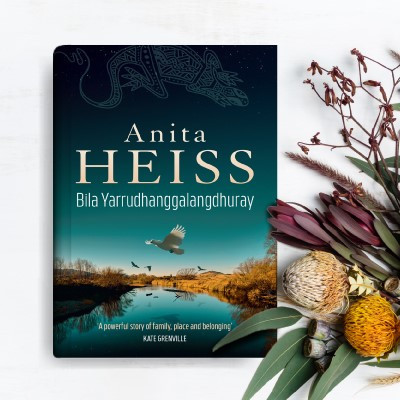
Please note: this this is not a comprehensive list – as I am still pulling all my handwritten notes together… it will be completed shortly.
A New Wiradjuri Dictionary, compiled by Stan Grant (Snr) and Dr John Rudder. Wagga Wagga, Restoration House, 2010.
Aboriginal Women’s Heritage: Wagga Wagga. Dept of Environment and Climate Change NSW, 2007.
Aboriginal Women’s Heritage: Brungle and Tumut. Dept of Environment and Climate Change NSW, 2007.
Blood on the Wattle: Massacres and Maltreatment of Aboriginal Australians since 1788, Bruce Elder. Frenchs Forest, New Holland, 2003.
Land of the Wiradjuri: Traditional Wiradjuri Culture, Paul Green- wood. Wagga Wagga, New South Wales Riverina Environmental Education Centre, 2014.
Wagga Wagga: A History, Sherry Morris. Wagga Wagga, Council of the City of Wagga Wagga, 1999.
Wagga Wagga Community Heritage Study Volume 2: Thematic History. Heritage Council of NSW with City of Wagga Wagga, 2013.
Wiradjuri Heritage Study for the Wagga Wagga Local Government Area of New South Wales, compiled by Go Green Services in conjunction with the Community of Wagga Wagga. 2002.
Wiradjuri of the Rivers and Plains, Iris Clayton and Alex Barlow. Port Melbourne, Heinemann Library Australia, 1997.
Wiradjuri Plant Use in the Murrumbidgee Catchment, compiled by Alice Williams and Tim Sides. Wagga Wagga, Murrumbidgee Catchment Management Authority, 2008.
Yarri: Hero of Gundagai, Allen Crooks. Gundagai, NSW, 1989.
June 5, 2021
Mandaang guwu Bidyadya Elaine Lomas and Canberra

Another shout out of thanks for who those who joined me in Canberra recently to celebrate the launch of #bilayarrudhanggalangdhuray It was truly a beautiful event thanks to the presence and words of Bidyadya Elaine Lomas (above) and all the miyagan and friends from across Canberra, Wagga and Sydney. Thank you to my minhi, Helen for performing a reading with me. Such a special moment for me. XO


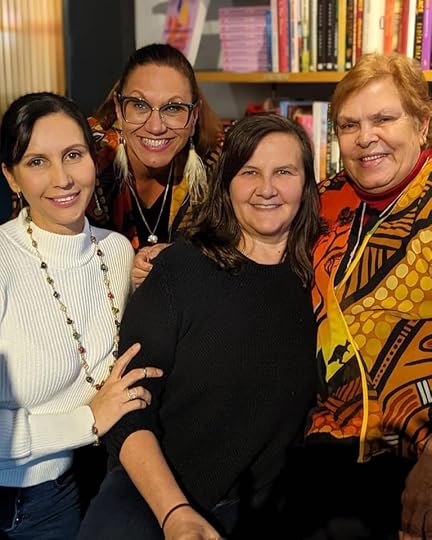
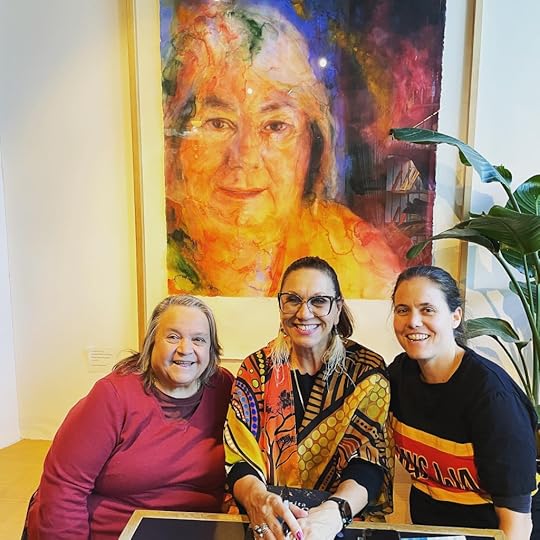


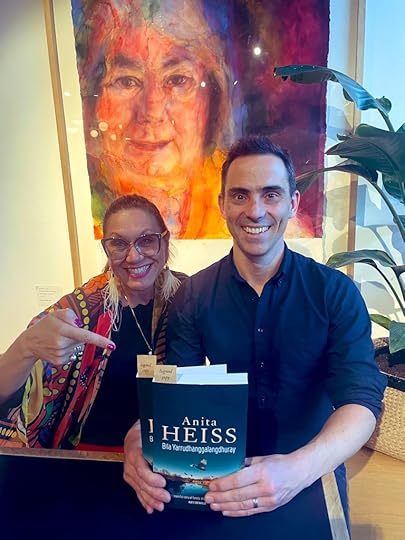

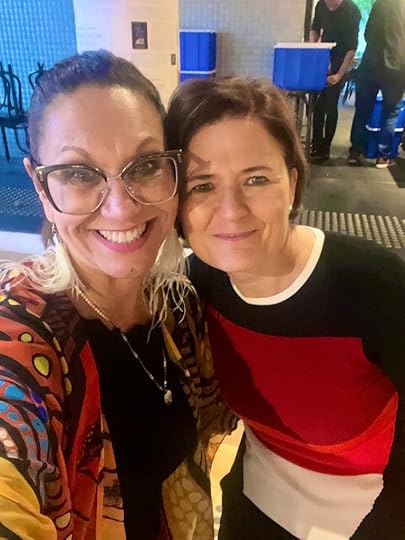
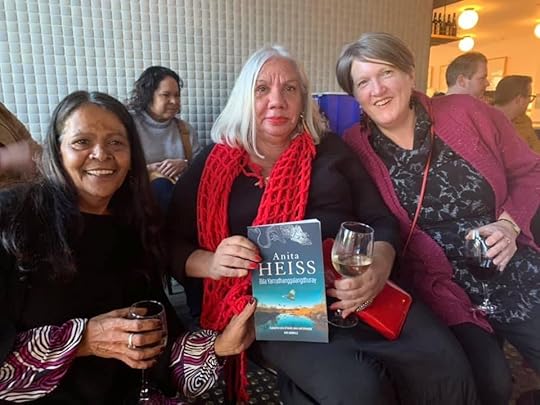




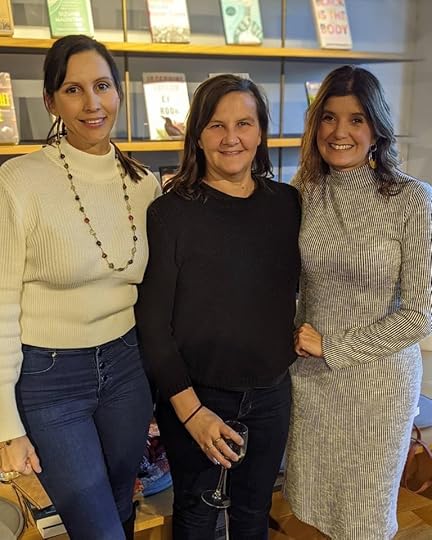









Many authors talk about their writing as a solitary, lonely experience. I never feel that. For me, the journey is always full of people who share the same world views and who value storytelling.
The event @musecanberra was the perfect example of that. So much love, warmth and humanity in one space.
Mandaang guwu to everyone who came and shared a chilly Sunday afternoon with me.
I’m remain incredibly grateful  to @simonschusterau
to @simonschusterau
PS I pinched other people’s photos! 


Five Questions with Krissy Kneen
I’m (re)starting the series of ‘Five Questions’ with some of my favourite authors, to shine a light on their work, the important stories they tell, their creative talent, and also to support Australian literature across genres, geography and cultures.
My first guest is Krissy Kneen, award-winning author of fiction, poetry and non-fiction including An Uncertain Grace which was shortlisted for the Stella Prize. She has written and directed broadcast television documentaries and is the current Copyright Agency Ltd Non-fiction Fellow. The Three Burials of Lotty Kneen is her latest book.


I’ve read all of Krissy’s works, and The Three Burials of Lotty Kneen is quite possibly equal favourite with The Wintering. I know, I know, it’s apples and oranges, but it’s also about engagement and being carried away by the storytelling. You’ll understand when you read them.
Over to Krissy…
Why did you decide to write this book now?
I could never write this book whilst my grandmother was alive. She would have forbidden it. When she died I felt that I could start to follow the threads of her history. I wanted to write this book whilst my mother was alive. I wanted it to be a gift of love to her. I’m not sure if my mother will actually read the book but I wanted to whisper this shared history to her, and now I feel like I have done this.
You combine memoir, history, poetry and even recipes. How did you decide to include a mix of forms?
It was a difficult and complicated process of research. How can you find out about your family history when you only have a scant trail of breadcrumbs to mark the way? I gathered everything I could along the way. I wasn’t sure what would turn out to be a clue and what would lead to a dead end. This gathering process turned out to be the perfect form for the book. I gathered and kept everything I could and much of this ended up on the page. It is a bit like collage, or perhaps it is more like making a model from paper mache. In that way I am carrying on my grandmother’s art form, recycling everything around me in an attempt to make somethingbeautiful.
How did it feel to set foot in Slovenia, your grandmother’s homeland for the first time?
I really thought it would be a revelation. I thought I’d walk the streets and see hundreds of different versions of myself. It was a disappointment to feel so different from everyone I saw in Ljubljana. There was an initial excitement when I saw the giant statues of dragons on the dragon bridge because that seemed to match my grandmother’s obsession with dragons, but after that I struggled to find glimpses of myself. It wasn’t until I travelled to Egypt and found the mixed-race grandchildren of Slovenian women migrant workers (Aleksandrinke) that I began to see myself. It is odd that cultural heritage can be so specific. I have such a strong connection to the Aleksandrinke and it is such a specific cohort of women but the experience was lifechanging for these women and their descendants have all been marked by it.
Men are remembered in the history books but women are often absent. Do you feel like you are adding to the knowledge of women’s history?
There is so much work that needs to be done to uncover the hidden histories of women. In Slovenia I was struck by how many statues of men – war heroes – there are and yet the one monument to the Aleksandrinke doesn’t even have a plaque near it to tell people what it is. After researching this book I became very passionate about finding some way to make sure these voices where heard. I funded a translation of the only first-person narratives by the Aleksandrinke that exist so now people can hear their voices in English. The process of researching and writing this book has really underlined the fact that women have historically been silenced. My book is just a tiny part of the process that will be ongoing. I don’t feel like we will be able to learn from the past unless we hear the voices of our female ancestors as well as those of the men.
The ghost of your grandmother haunts the book, do you feel like this book has allowed her ghost to rest?
I think I have realised through the writing of this book that my grandmother and I are and will always be intimately entwined. Every story I tell is in some way influenced by her. She is the first and strongest voice in my life and I have folded her into myself. The ghost of my grandmother will always be inside me. Sometimes she will be calm and at other times she will be restless but she will always be the driving force behind my creativity. I believe that all the stories we tell are just ways of trying to make sense of ourselves and our communities. This book has helped me accept that my grandmother has brought me into a strong and important community. I am truly grateful that I am finally a part of a community. I hope my work from here on will honour that legacy.
You can follow Krissy on Twitter, Facebook and Instagram.
And one of the best things you can do to support your favourite authors, is to review their work on Goodreads.
May 30, 2021
Mandaang guwu Tumut

Mandaang guwu (thank you) to all the beautiful peoples who joined in the celebrations for Bila Yarrudhanggalangdhuray (River of Dreams) at Tumut Library, kicked off by a heart melting acknowledgement to country in Wiradyuri and English by the Brungle Public School kids.

Thank you to Aunty Sue and Aunty Winnie Bulger for launching Bila Yarrudhanggalangdhuray with for your reflections on the novel, the heroes, and realities of life for Wiradjuri people over time.
What a wonderful way to spend a morning with the Russell clan, students from Tumut High School and locals who just like to read and are interested in First Nations stories.
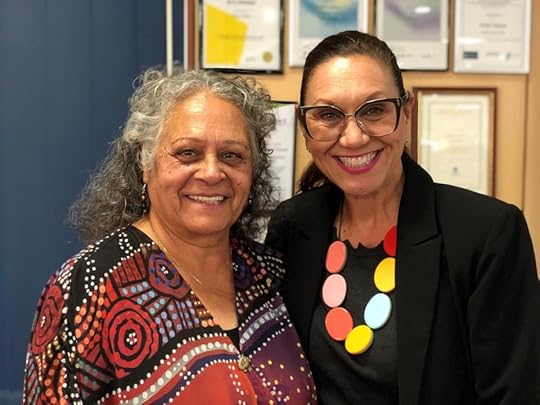
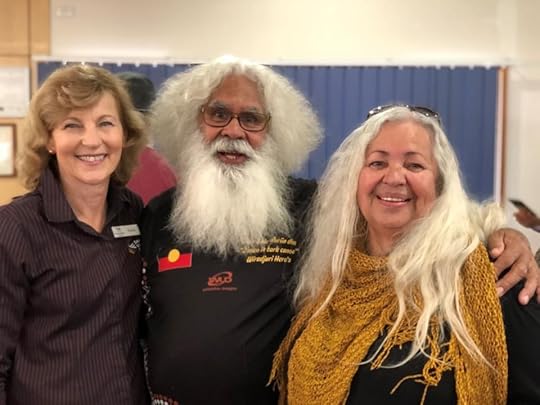
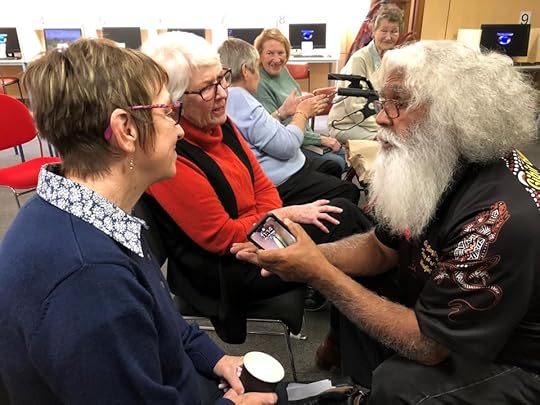




It was a joy to also celebrate Uncle Pat Connolly’s birthday as well. Look at that amazing cake made by librarian Kristin Twomey!

Thank you to Kristin, Rhonda and all the team at the Tumut Regional Library for hosting us and for you great pics on Facebook!

And huge thanks to Mel from Collins Books Wagga Wagga for being the traveling bookseller. If you are local to Wagga, there are signed copies in-store now! If you are not local you can order through Collins online here.
And thanks also to Emily Wind from the Tumut and Adelong Times for coming along and covering the launch for the paper.
May 28, 2021
Mandaang guwu Gundagai



On May 13 I returned to Gundagai to launch Bila Yarrudhanggalangdhuray and to thank the Yarri and Jacky Jacky Sculpture Committee for bringing the heroes to national attention.
It was also an opportunity to publicly thank our Matriarch, Aunty Sony for her love, support and wisdom, because without Elders like Aunty Sony I wouldn’t even attempt the work I do.
Launching the novel in Gundagai gave me the chance to thank Miriam Crane – from the Cootamundra Gundagai Regional Council – for her counsel and knowledge during the long process of researching and writing this epic story.
Cousin Luke Penrith was there and I love telling everyone about his amazing artwork of the gugaa on the cover. I was also wearing one of his stunning scarves. Check out his work here.
Traveling from Tumut and Wagga Wagga were my deadly minhi-galang Bec and Regina Russell (and Aunty Elva), Sue Townsend and Cheryl Penrith – I so grateful for absolutely everything they have brought to my life since day one of our language journey together.



The evening was also special because in attendance was Ian Horsley, a direct descendant of a survivor of the flood – Ian’s great-grandfather was rescued by Yarri back in 1852.
I have always found Gundagai Library a welcoming place, and the librarians are extraordinary. Check out the cover re-created (below) by Cindy on the wall of the library especially for the launch, just too deadly.
[image error][image error]

It was a blessing also to have the publishing A-Team from Simon & Schuster present as well – thank you Cass di Bello (with me in the last photo) and Dan Ruffino and Cheryl Akle from Better Reading for getting this story out to the world. Thank you for the Facebook Live, Cheryl!


And finally, thank you Mel (with me above) from Collins Booksellers in Wagga for traveling to Gundagai and Tumut to support the book a well. If you’re local you can grab a copy from Mel instore or online.

 [image error][image error]
[image error][image error]
Bila Yarrudhanggalangdhuray is out in the world – mandaang guwu Meanjin


On May 5, my new novel Bila Yarrudhanggalangdhuray was officially released into the world. To celebrate we had a beautiful launch in Brisbane, hosted by Simon & Schuster with BlakLash Creative.Troy Casey band Amanda Hayman were amazing and sensational hosts and of course young Charlie stole the show as always. There should be more babies at book launches, that’s for sure.
It was a night of storytelling, reunions and love and I offer heart-felt thanks to my good friend, the Honourable Leeane Enoch for her beautiful words while launching my novel and for sharing her own reflections on the story.
Mandaang guwu to all my Brisbane family and friends who came along to help me celebrate the launch, although we were stifled a little by COVID rules. There are too many people to mention without the risk of leaving people out, but please enjoy the slide show and know that I send thanks to each and every one of you.
It was also significant moment in my publishing career as this, my 18th book, is very close to my heart, for the novel carries the stories and the language of my Wiradyuri Ancestors.
I do want to give a shout out to my amazing team from Simon & Schuster, Cass Di Bello my gorgeous publisher, Dan Ruffino (Managing Director from heaven) and Anna O’Grady, my incredible publicist. I am grateful we are doing this long storytelling journey together.
To purchase a copy of Bila Yarrudhanggalangdhuray head into your local bookstore, or national stories like Dymocks, Collins, QBD, Big W, Kmart and Target all carry it as well. Or click here to link booksellers Australia-wide.
Thank you for your support.
Yindyamarra,
Yaaniidha XO

